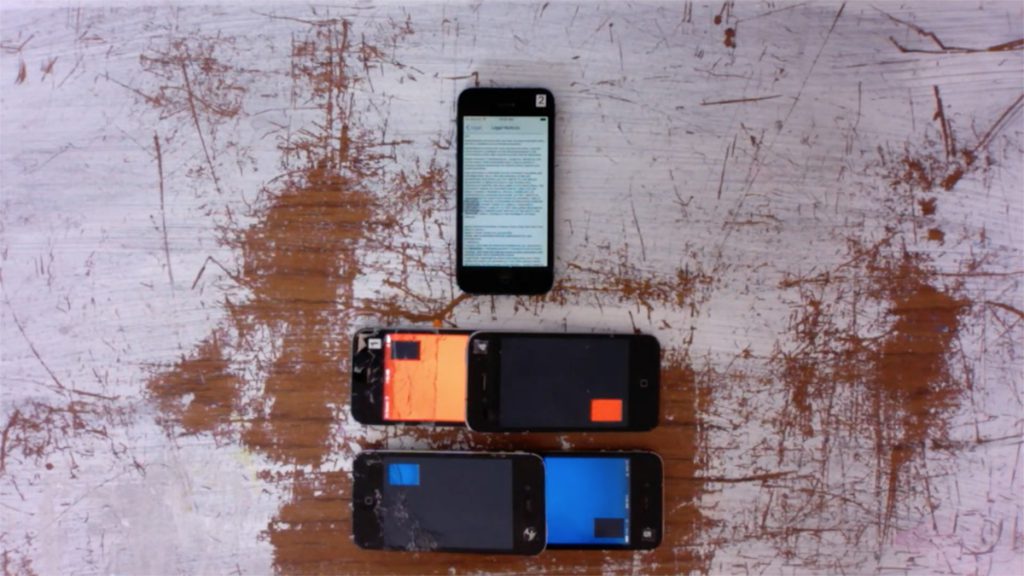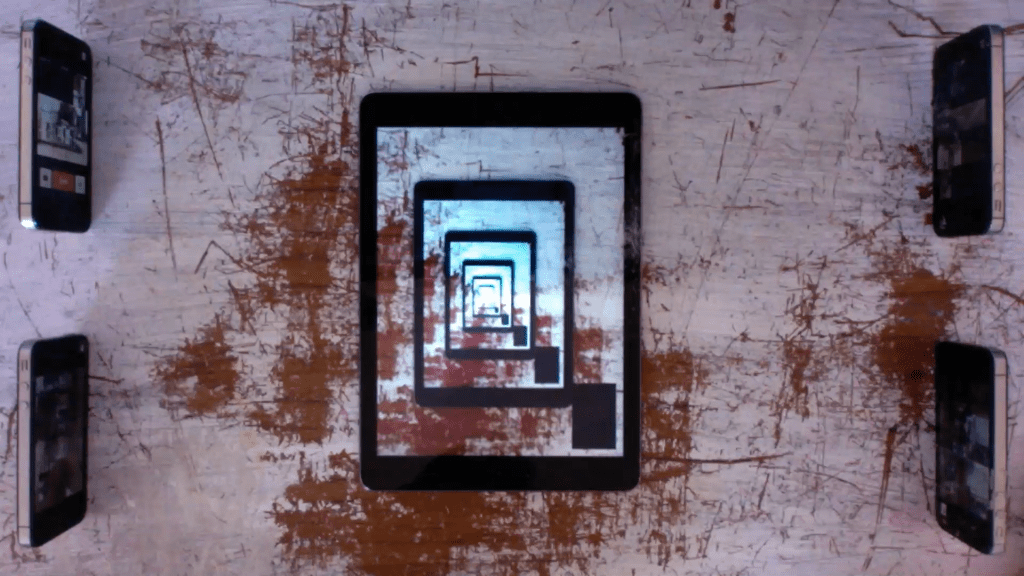Best Before: Colby Richardson’s Performance for Aging Apple Devices
17 February 2022
By Madeline Bogoch
Last year at Platform Centre in Winnipeg, during a slyly theatrical lecture-performance by emerging media artist Colby Richardson, the tall and affable filmmaker quoted fellow Winnipeg artist Mike Maryniuk: “I work with the latest technology to hit the local thrift stores.” This sentiment is an ethos that echoes through Richardson’s interdisciplinary practice, which habitually resurrects media detritus by placing it into bold new arrangements, in order to revel in the afterlife of obsolete equipment. As significant a role as these technologies have played in Richardson’s practice, I took his framing of Maryniuk’s quote to imply that his was not an aesthetics of nostalgia, but rather of access and experimentation.
I thought back to this while watching a live-streamed performance of Richardson’s most recent work, Performance for Aging Apple Devices (2020) which was co-presented by Platform and The Art Gallery of Regina and broadcast on YouTube and Instagram channels created to host the work in June of 2020. While the artist has previously worked with more obscure analogue apparatuses, such as video synthesizers and Amiga consoles, this performance centred on the ubiquitous iPhone—more specifically the outmoded models that occupy cluttered junk drawers and piles of e-waste the world over. Though there’s a certain fetishization that surrounds older technologies, the devices used in this performance felt too recent to possess this appeal. Yet precisely what made this performance so compelling was Richardson’s choice to use one of the least charismatic avatars of desuetude—objects that nearly all of us have damaged and discarded (or dropped in toilets).
In the spirit of expanded cinema, a hybrid genre which transgresses the traditional dynamic between screen and viewer, the performance’s staged FaceTime calls between the devices to establish a feedback loop of sounds and visual effects derived solely from the phones’ preset features. Streamed live, the performance bounced the front-facing camera feed back and forth between the screens forming a circuit of reflections, each projecting the image of the opposite device. Throughout the roughly 35-minute span of the performance, the complexity of the composition gradually compounded as more devices (mostly phones, though an iPad made an appearance) entered the frame, layering channels of feedback and creating a psychedelic hall of mirrors effect. Filmed from above, the artist was mostly absent except for his hands, which orchestrated the devices, exaggerating the familiar gestures of swiping and scrolling that have become endemic in our daily lives. At the conclusion of the piece, Richardson abruptly slid the phones off the table one by one, offering a glimmer of playfulness and recalling the indelicate treatment these devices often endure. Works that trade in medium-specificity, taking the materials used as a primary subject for the piece, can run the risk of being weighed down by opacity or pretension, yet Richardson avoids this trap with his sporadic touches of levity. As a result, it was especially endearing to watch a performance that balanced these structuralist inquiries with a sense of humour.

There’s an additional timeliness to the venue Richardson had chosen: performed live and streamed on YouTube and Instagram, the work was meant to be viewed on multiple channels at once. This meant viewers had to navigate the arrangement of screens using whatever working devices they had on hand. While I am cautious about overloading significance onto the unique social circumstances surrounding the performance, it’s impossible to entirely separate the piece from its mid-pandemic context. Although it was planned in this form prior to lockdown, the effect of viewing the work alone on multiple devices simultaneously was crystalline to the moment of collective and simultaneous isolation.
Performing dual roles as both instrument and subject, the cracked-screen iPhone, featured prominently here, was an ideal totem for our culture of rapid, planned obsolescence. In this context, not only did these objects symbolize their short shelf-life, but Performance for Aging Apple Devices also suggested the commensurate acceleration of the outmoded-to-fetish pipeline, the pace by which obsolete technology returns to culture in the form of collective nostalgia.1 While much of the cultural discourse around technology oscillates between reproach and reverence, Richardson’s performance avoided this cliché—if there was a virtue espoused in his performance, it was resourcefulness rather than abstention. Freeing the performance from the burden of didacticism allowed the underlying playfulness to flourish, and cleverly escaped the poles of deprivation and determinism that so often frame discussions around technology.
If the physical condition of the phones indexed their inherent disposability, then the sounds they produced expressed the relentless grip they have on their users’ psyches. Richardson clearly recognized this bondage, and instrumentalized these functions in order to provoke some Pavlovian triggers. At one point, the artist used the text-to-speech function to recite the iTunes terms of service agreement at a delayed speed. This part in particular gestured towards the broader attitude of the work: a hacker-adjacent mischievousness, derived out of an implicit insolence in subverting the phone’s intended use. The viewer’s familiarity with the devices was leveraged well in Performance for Aging Apple Devices, which exploited the hyper-legibility of the objects to exhibit the raw potential in their creative misuse.
Expanded cinema has a long history of redefining the experience of spectatorship. These genre-bending works are often better suited to gallery spaces than to cinemas, but Performance for Aging Apple Devices belongs to neither. It thrives online, having been streamed live for an audience whose viewership was likely mediated by the same hardware the work interrogated. As atomizing as this mediation can be, Richardson has managed to negotiate these conditions by bringing the spirit of expanded cinema into the intimate realm of the smartphone. Whether premeditated or not, the question of ‘liveness’ which has haunted the discourse surrounding moving-image performance, was elicited here in a hyper-timely fashion. Performance for Aging Apple Devices succeeded because it did not attempt to simulate an unmediated experience, rather it embraced limitation as a catalyst for experimentality—which is, after all, a timeless attitude.
- The notion that the recent past is being prematurely retrieved as “retro” to the detriment of cultural novelty is explored in depth by author Simon Reynolds in his book Retromania: Pop Culture’s Addiction to Its Own Past (2010). A similar phenomenon is described by theorist Mark Fisher as “the slow cancellation of the future” in Ghosts of My Life: Writings on Depression, Hauntology, and Lost Futures (2014).
Performance for Aging Apple Devices by Colby Richardson was virtually performed and co-presented by the Art Gallery of Regina, SK and Platform Centre for Photographic and Digital Arts in Winnipeg, MB in 2020. Watch the full performance documentation on YouTube Here.
Feature Image: Performance still from Performance for Aging Apple Devices, 2020 by Colby Richardson. Photo courtesy of the artist.



